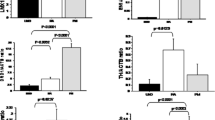Abstract
The human Lesch–Nyhan syndrome is a rare neurological and behavioural disorder, affecting only males, which is caused by an inherited deficiency in the level of activity of the purine salvage enzyme hypoxanthine-guanosine phosphoribosyl transferase (HPRT)1–3. How the resulting alterations in purine metabolism lead to the severe symptoms characteristic of Lesch–Nyhan patients is still not understood3,4. No mutations at the Hprt locus leading to loss of activity have been described in laboratory animals. To derive an animal model for the Lesch–Nyhan syndrome, we have used cultured mouse embryonic stem cells5, mutagenized by retroviral insertion and selected for loss of HPRT activity, to construct chimaeric mice6,7. Two clonal lines carrying different mutant Hprt alleles have given rise to germ cells in chimaeras, allowing the derivation of strains of mutant mice having the same biochemical defect as Lesch–Nyhan patients. Male mice carrying the mutant alleles are viable and analysis of their cells shows a total lack of HPRT activity.
Similar content being viewed by others
References
Lesch, M. & Nyhan, W. L. Am. J. Med. 36, 561–570 (1964).
Seegmiller, J. E., Rosenbloom, F. M. & Kelley, W. N. Science 155, 1682–1684 (1967).
Kelley, W. N. & Wyngaarden, J. B. in The Metabolic Basis of Inherited Diseases 5th edn (eds Stanbury, J. B., Wyngaarden, J. B., Fredrickson, D. S., Goldstein, J. L. & Brown, M. S.) 1115–1143 (McGraw-Hill, New York, 1983).
Stout, J. T. & Caskey, C. T. A. Rev. Genet. 19, 127–148 (1985).
Evans, M. J. & Kaufman, M. H. Nature 292, 154–156 (1981).
Bradley, A., Evans, M., Kaufman, M. H. & Robertson, E. Nature 309, 255–256 (1984).
Robertson, E., Bradley, A., Kuehn, M. & Evans, M. Nature 323, 445–448 (1986).
King, W., Patel, M. D., Lobel, L. I., Goff, S. P. & Nguyen-Huu, C. Science 228, 554–558 (1985).
Hooper, M. L. Mammalian Cell Genetics (Wiley, New York, 1985).
Littlefield, J. W. Science 145, 709–710 (1964).
Melton, D. W., Konecki, D. S., Brennand, J. & Caskey, C. T. Proc. natn. Acad. Sci. U.S.A. 81, 2147–2151 (1984).
Nesbitt, M. N. & Franke, U. Chromosoma 41, 145–158 (1973).
Burgoyne, P. S. & Baker, T. G. J. Reprod. Fert. 61, 207–212 (1981).
Rosenbloom, F. M., Kelly, W. N., Henderson, J. F. & Seegmiller, J. E. Lancet ii, 305–306 (1967).
Migeon, B. R., Der Kaloustian, V. K., Nyhan, W. L., Young, W. J. & Childs, B. Science 160, 425–427 (1968).
Hooper, M., Hardy, K., Handyside, A., Hunter, S. & Monk, M. Nature 326, 292–295 (1987).
Dewey, M. J., Martin, D. W. Jr, Martin, G. R. & Mintz, B. Proc. natn. Acad. Sci. U.S.A. 74, 5564–5568 (1977).
Migeon, B. R. Biochem. Genet. 4, 377–383 (1970).
Fujimoto, W-Y. & Seegmiller, J. E. Proc. natn. Acad. Sci. U.S.A. 65, 577–584 (1970).
Willis, R. C. et al. J. biol. Chem. 259, 7842–7849 (1984).
Miller, A. D., Eckner, R. J., Jolly, D. J., Friedmann, T. & Verma, I. M. Science 225, 630–632 (1984).
Patel, P. I. & Caskey, C. T. BioEssays 2, 4–8 (1986).
Thomas, K. R., Folger, K. R. & Cappechi, M. R. Cell 44, 419–428 (1986).
Smithies, O., Gregg, R. G., Boggs, S. S., Koralewski, M. A. & Kucherlapati, R. S. Nature 317, 230–234 (1985).
Mann, R., Mulligan, R. C. & Baltimore, D. Cell 33, 153–157 (1983).
Stocking, C., Kollek, R., Bergholz, U. & Ostertag, W. Proc. natn. Acad. Sci. U.S.A. 82, 5746–5750 (1985).
Konecki, D. S., Brennand, J., Fuscoe, J. C., Caskey, C. T. & Chinault, A. C. Nucleic Acids Res. 10, 6763–6775 (1982).
Hogan, B., Costantini, F. & Lacy, E. Manipulating the Mouse Embryo—a Laboratory Manual (Cold Spring Harbor Laboratory, New York, 1986).
Author information
Authors and Affiliations
Rights and permissions
About this article
Cite this article
Kuehn, M., Bradley, A., Robertson, E. et al. A potential animal model for Lesch–Nyhan syndrome through introduction of HPRT mutations into mice. Nature 326, 295–298 (1987). https://doi.org/10.1038/326295a0
Received:
Accepted:
Issue Date:
DOI: https://doi.org/10.1038/326295a0
- Springer Nature Limited
This article is cited by
-
Genetically modified mice as a tool for the study of human diseases
Molecular Biology Reports (2024)
-
Deep brain stimulation in Lesch-Nyhan syndrome: a systematic review
Neurosurgical Review (2023)
-
LRRC15+ myofibroblasts dictate the stromal setpoint to suppress tumour immunity
Nature (2022)
-
Induced pluripotent stem cells from subjects with Lesch-Nyhan disease
Scientific Reports (2021)
-
Geometrically defined environments direct cell division rate and subcellular YAP localization in single mouse embryonic stem cells
Scientific Reports (2021)





